Development and Characterization of PBSA-Based Green Composites in 3D-Printing by Fused Deposition Modelling
Abstract
:1. Introduction
2. Materials and Methods
2.1. Filament Extrusion and 3D Printing
2.2. Mechanical Characterization
2.3. Thermogravimetric Analysis TGA
2.4. Differential Scanning Calorimetry (DSC)
2.5. Porosity Content Measurement
3. Results and Discussion
3.1. Tensile Mechanical Properties
Porosity and Morphological Characterisation
3.2. Thermal Properties of a WCPBSA Filament
DSC Measurement
3.3. Rheological Characterization
3.4. Charpy Impact Tests
4. Conclusions
Author Contributions
Funding
Acknowledgments
Conflicts of Interest
References
- Peltola, H.; Pääkkönen, E.; Jetsu, P.; Heinemann, S. Wood based PLA and PP composites: Effect of fibre type and matrix polymer on fibre morphology, dispersion and composite properties. Compos. Part A: Appl. Sci. Manuf. 2014, 61, 13–22. [Google Scholar] [CrossRef]
- Melo, K.; Santos, T.; Santos, C.; Fonseca, R.; Dantas, N.; Aquino, M. Experimental Analysis of Styrene, Particle Size, and Fiber Content in the Mechanical Properties of Sisal Fiber Powder Composites. In Hybrid Fiber Composites: Materials, Manufacturing, Process Engineering; Elsevier: Amsterdam, The Netherlands, 2020; pp. 351–367. [Google Scholar] [CrossRef]
- Yang, H.-S.; Kim, H.-J.; Park, H.-J.; Lee, B.-J.; Hwang, T.-S. Water absorption behavior and mechanical properties of lignocellulosic filler–polyolefin bio-composites. Compos. Struct. 2006, 72, 429–437. [Google Scholar] [CrossRef]
- Unterweger, C.; Bruggemann, O.; Furst, C. Synthetic fibers and thermoplastic short-fiber-reinforced polymers: Properties and characterization. Polym. Compos. 2014, 35, 227–236. [Google Scholar] [CrossRef]
- Yorseng, K.; Rangappa, S.M.; Pulikkalparambil, H.; Siengchi, S.; Parameswaranpillai, J. Accelerated weathering studies of ke-naf/sisal fiber fabric reinforced, fully biobased hybrid bioepoxy composites for, semi-structural, applications: Mor-phology, thermo mechanical, water, absorption behavior and surface hydrophobicity. Constr. Build Mater. 2020, 235, 117464. [Google Scholar] [CrossRef]
- Mokhena, T.C.; John, M.J. Cellulose nanomaterials: New generation materials for solving global issues. Cellulose 2020, 27, 1149–1194. [Google Scholar] [CrossRef]
- Yashas, G.T.G.; Sanjay, M.R.; Subrahmanya, B.K.; Madhu, P.; Senthamaraikannan, P.; Yogesha, B. Polymermatrix-natural fiber compo-sites: An overview. Cogent Eng. 2018, 5, 1446667. [Google Scholar] [CrossRef]
- Xu, W.; Pranovich, A.; Uppstu, P.; Wang, X.; Kronlund, D.; Hemming, J.; Öblomd, H.; Moritzef, N.; Preisd, M.; Sandlerd, N.; et al. Novel biorenewable com-posite of wood polysaccharide and polylactic acid for three dimensional printing. Carbohydr. Polym. 2018, 187, 51–58. [Google Scholar] [CrossRef]
- Yao, T.; Deng, Z.; Zhang, K.; Li, S. A method to predict the ultimate tensile strength of 3D printing polylactic acid (PLA) materials with different printing orientations. Compos. Part B: Eng. 2019, 163, 393–402. [Google Scholar] [CrossRef]
- Carlier, E.; Marquette, S.; Peerboom, C.; Denis, L.; Benali, S.; Raquez, J.-M.; Amighi, K.; Goole, J. Investigation of the parameters used in fused deposition modeling of poly(lactic acid) to optimize 3D printing sessions. Int. J. Pharm. 2019, 565, 367–377. [Google Scholar] [CrossRef] [PubMed]
- Sui, T.; Salvati, E.; Zhang, H.; Nyaza, K.; Senatov, F.S.; Salimon, A.I.; Korsunsky, A.M. Probing the complex thermo-mechanical properties of a 3D-printed polylactide-hydroxyapatite composite using in situ synchrotron X-ray scattering. J. Adv. Res. 2019, 16, 113–122. [Google Scholar] [CrossRef]
- Petchwattana, N.; Channuan, W.; Naknaen, P.; Narupai, B. 3D printing filaments prepared from modified poly (lactic acid)/teak wood flour composites: An investigation on the particle size effects and silane coupling agent compatibilisation. J. Phys. Sci. 2019, 30, 169–188. [Google Scholar] [CrossRef]
- Ngo, T.D.; Kashani, A.; Imbalzano, G.; Nguyen, K.T.Q.; Hui, D. Additive manufacturing (3Dprinting): A review of materials, methods, applications and challenges. Compos. Part B Eng. 2018, 143, 172–196. [Google Scholar] [CrossRef]
- Faruk, O.; Bledzki, A.K.; Fink, H.-P.; Sain, M. Biocomposites reinforced with naturalfi-bers: 2000–2010. Prog. Polym. Sci. 2012, 37, 1552–1596. [Google Scholar] [CrossRef]
- Le Duigou, A.; Davies, P.; Baley, C. Substitution of glass/polyester composites byflax/PLLAbiocomposites. Is is justified? J. Biobased Mater. Bioenergy 2011, 5, 466–482. [Google Scholar]
- Filgueira, D.; Holmen, S.; Melbø, J. Enzymatic-assisted modification of TMP fibres for improving the interfacial adhesion with PLA for 3D printing. ACS Sustain. Chem. Eng. 2017, 5, 9338–9346. [Google Scholar] [CrossRef]
- Christiyan, K.J.; Chandrasekhar, U.; Venkateswarlu, K. Influence of raster orientation and layer thickness on mechanical properties of ABS material using FDM process. In Proceedings of the International Conference on Emerging Trends in Science and Cutting Edge Technology (ICETSCET-2014), New Delhi, India, 28 September 2014. [Google Scholar]
- Savvakis, K.; Petousis, M.; Vairis, A.; Vidakis, N.; Bikmeyev, A.T. Experimental determinationof the tensile strength of fused deposition modeling parts. In Proceedings of the ASME 2014 International Mechanical Engineering Congress and Exposition, Montreal, QC, Canada, 14–20 November 2014; Volume 14. [Google Scholar]
- Hwang, S. Study of Materials and Machines for 3D Printed Large-Scale, Flexible Electronic Structures Using Fused Deposition Modeling. Ph.D. Thesis, The University of Texas at El Paso, El Paso, TX, USA, 2015. [Google Scholar]
- Revati, R.; Majid, M.A.; Ridzuan MJ, M.; Normahira, M.; Nasir, N.M.; Gibson, A.G. Mechanical, thermal and mor-phological characterisation of 3D porous Pennisetum purpureum/PLA biocomposites scaffold. Mater. Sci. Eng. C 2017, 75, 752–759. [Google Scholar] [CrossRef] [Green Version]
- Díez, D.; Urueña, A.; Piñero, R.; Barrio, A.; Tamminen, T. Determination of Hemicellulose, Cellulose, and Lignin Content in Different Types of Biomasses by Thermogravimetric Analysis and Pseudocomponent Kinetic Model (TGA-PKM Method). Processes 2020, 8, 1048. [Google Scholar] [CrossRef]
- Rego, F.; Soares Dias, A.P.; Casquilho, M.; Rosa, F.C.; Rodrigues, A. Fast determination of lignocellulosic composi-tion of poplar biomass by thermogravimetry. Biomass Bioenergy 2019, 122, 375–380. [Google Scholar] [CrossRef]
- Abe, M.; Enomoto, Y.; Seki, M.; Miki, T. Esterification of solid wood for plastic forming. BioResources 2020, 15, 6282–6298. [Google Scholar] [CrossRef]
- Girard, M.; Combeaud, C.; Billon, N. Effects of annealing prior to stretching on strain induced crystalliza-tion of polyethylene terephthalate. Polymer 2021, 230, 124078. [Google Scholar] [CrossRef]
- Chinga-Carrasco, G. Potential and Limitations of Nanocelluloses as Components in Biocomposite Inks for Three-Dimensional Bioprinting and for Biomedical Devices. Biomacromolecules 2018, 19, 701–711. [Google Scholar] [CrossRef] [PubMed]
- Fan, X.; Wen, F.; Shi, X.; Yang, L.; Hussain, M.; Song, Y.; Zheng, Q. Roles played by novolac resin on rubber compounding, reinforcement and nonlinear rheological behaviors. Polymer 2020, 207, 122895. [Google Scholar] [CrossRef]
- Adams, J.M. Particle Size and Shape Effects in Materials Science: Examples from Polymer and Paper Systems. Clay Miner. 1993, 28, 509–530. [Google Scholar] [CrossRef]
- Koffi, A.; Koffi, D.; Toubal, L. Mechanical properties and drop-weight impact performance of injection-molded HDPE/birch fiber composites. Polym. Test. 2020, 93, 106956. [Google Scholar] [CrossRef]
- Delli, E.; Giliopoulos, D.; Bikiaris, D.N.; Chrissafis, K. Fibre length and loading impact on the properties of glass fibre reinforced polypropylene random composites. Compos. Struct. 2021, 263, 113678. [Google Scholar] [CrossRef]
- Ilyas, R.; Sapuan, S.; Harussani, M.; Hakimi, M.; Haziq, M.; Atikah, M.; Asyraf, M.; Ishak, M.; Razman, M.; Nurazzi, N.; et al. Polylactic Acid (PLA) Biocomposite: Processing, Additive Manufacturing and Advanced Applications. Polymers 2021, 13, 1326. [Google Scholar] [CrossRef]

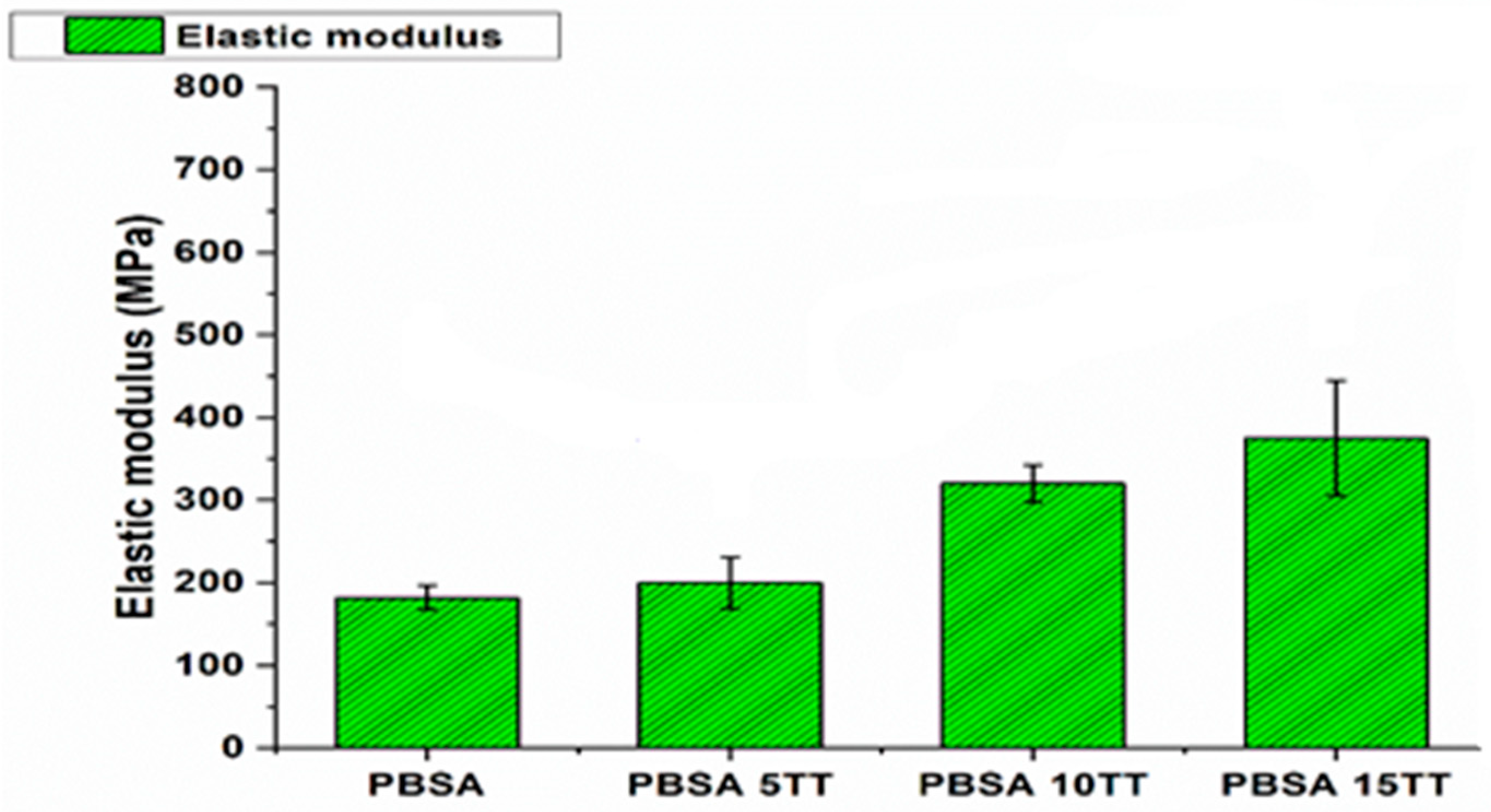



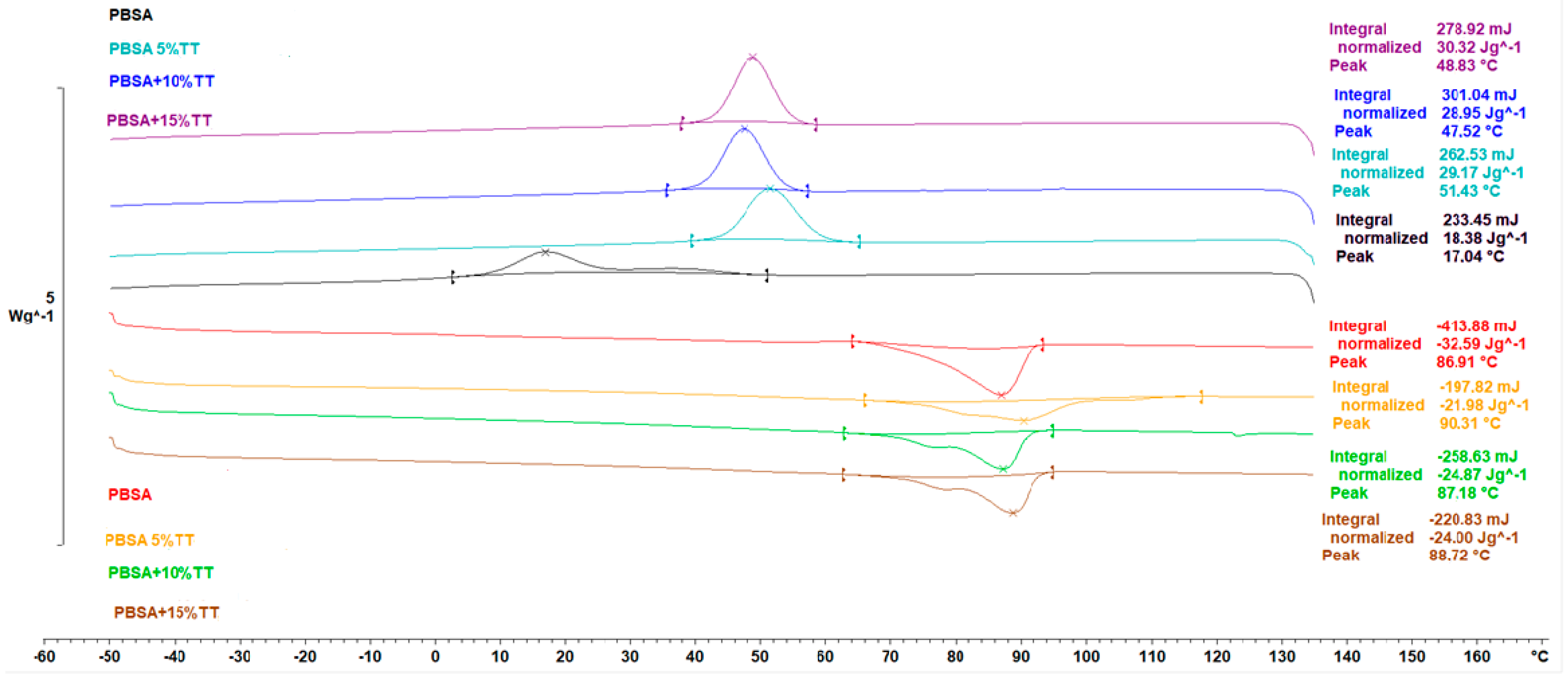
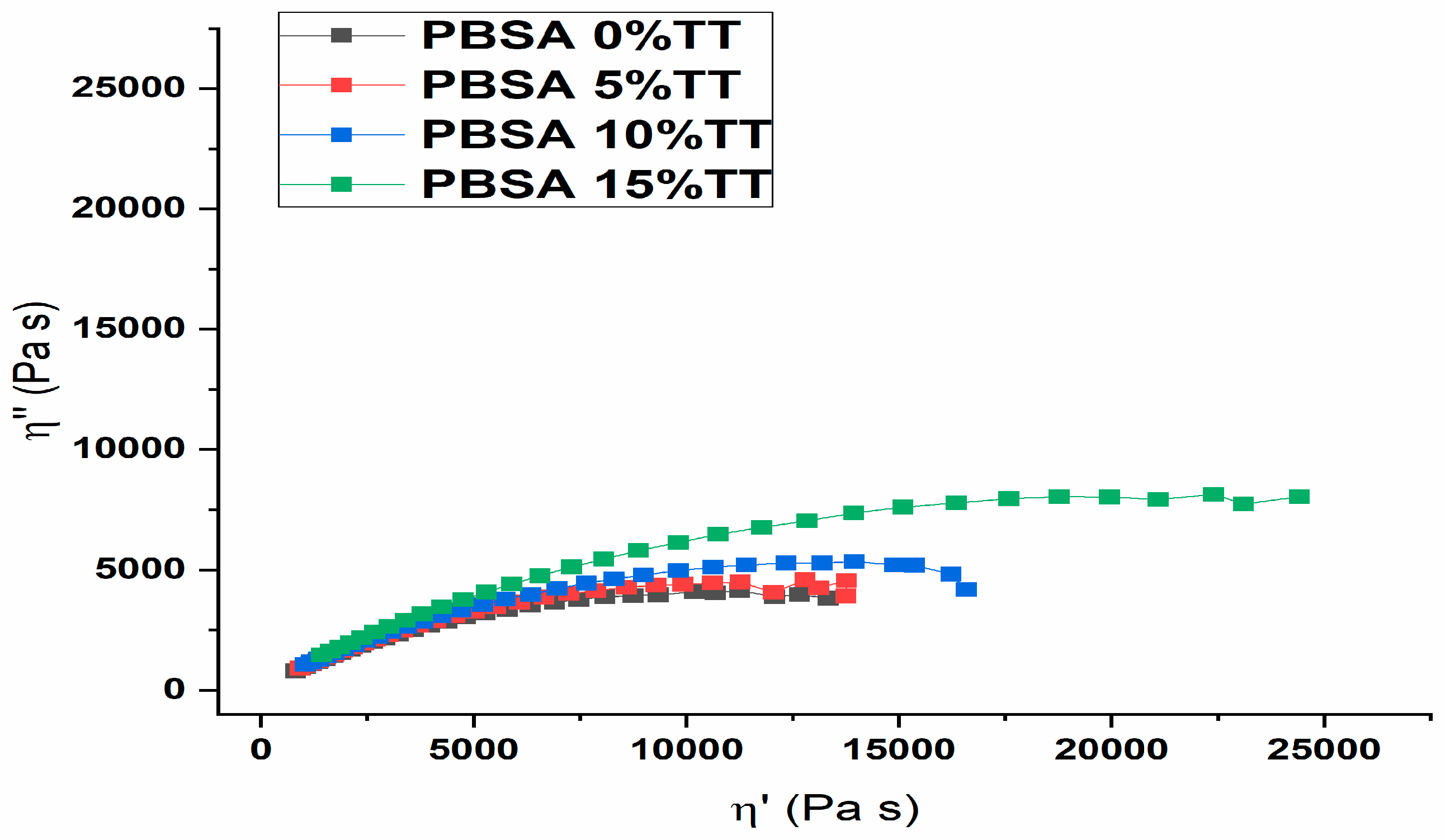
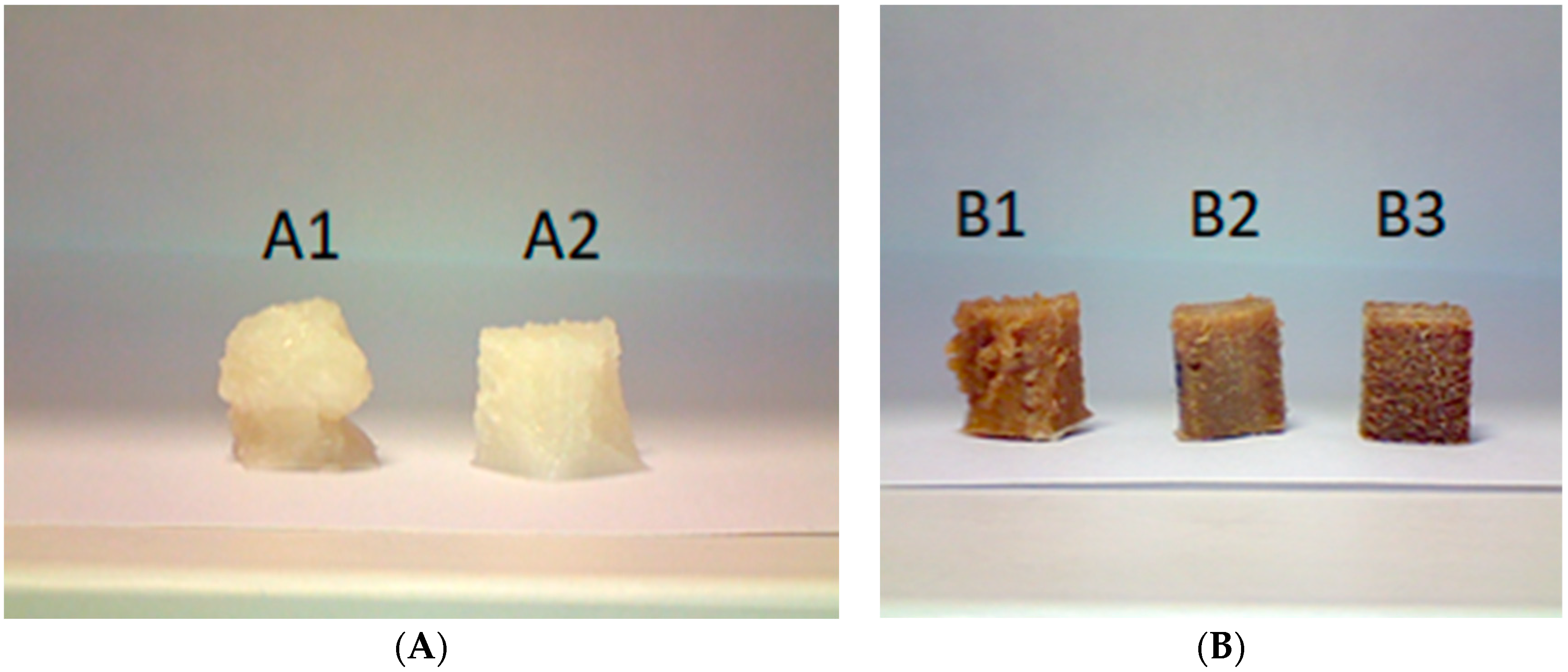
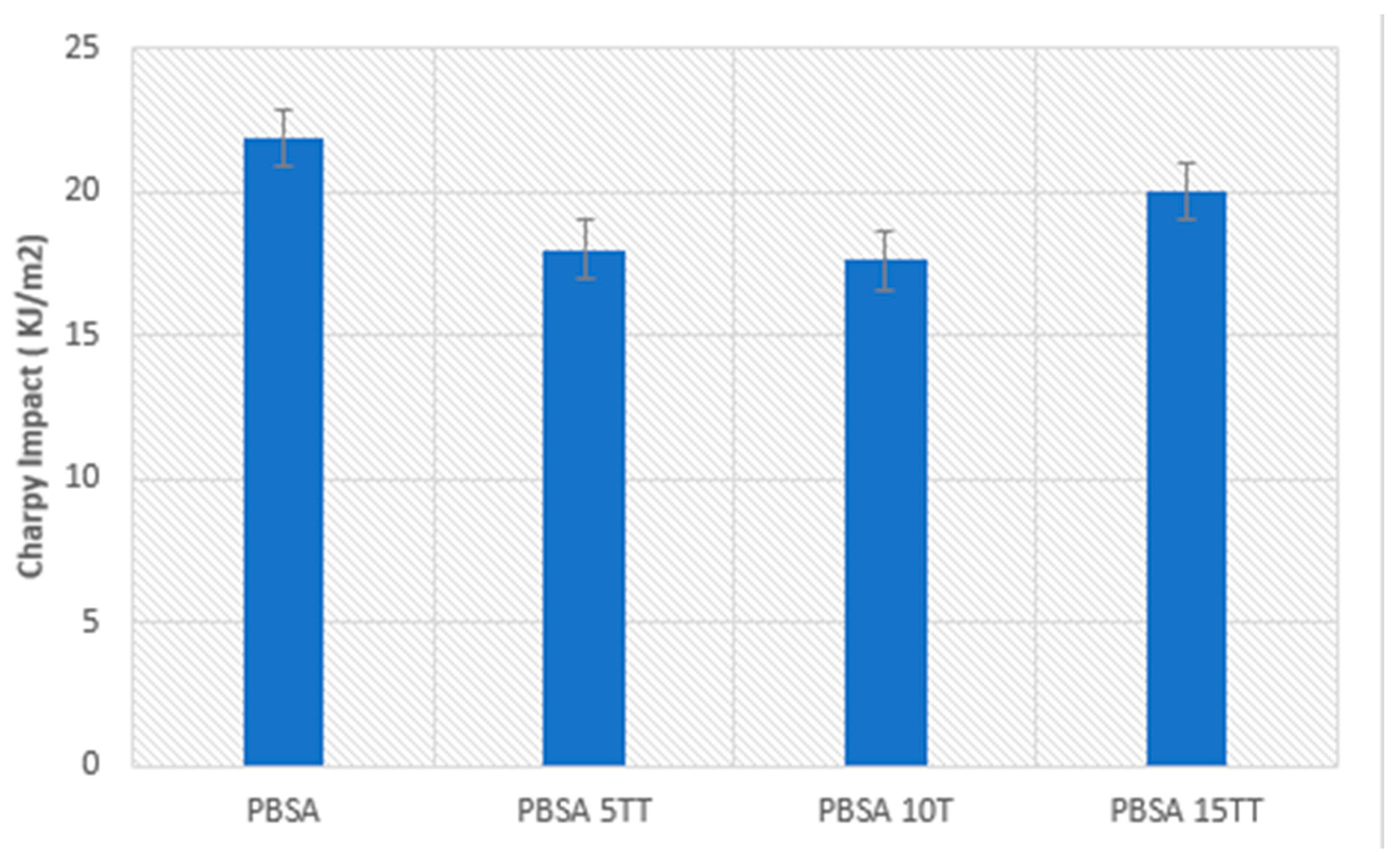
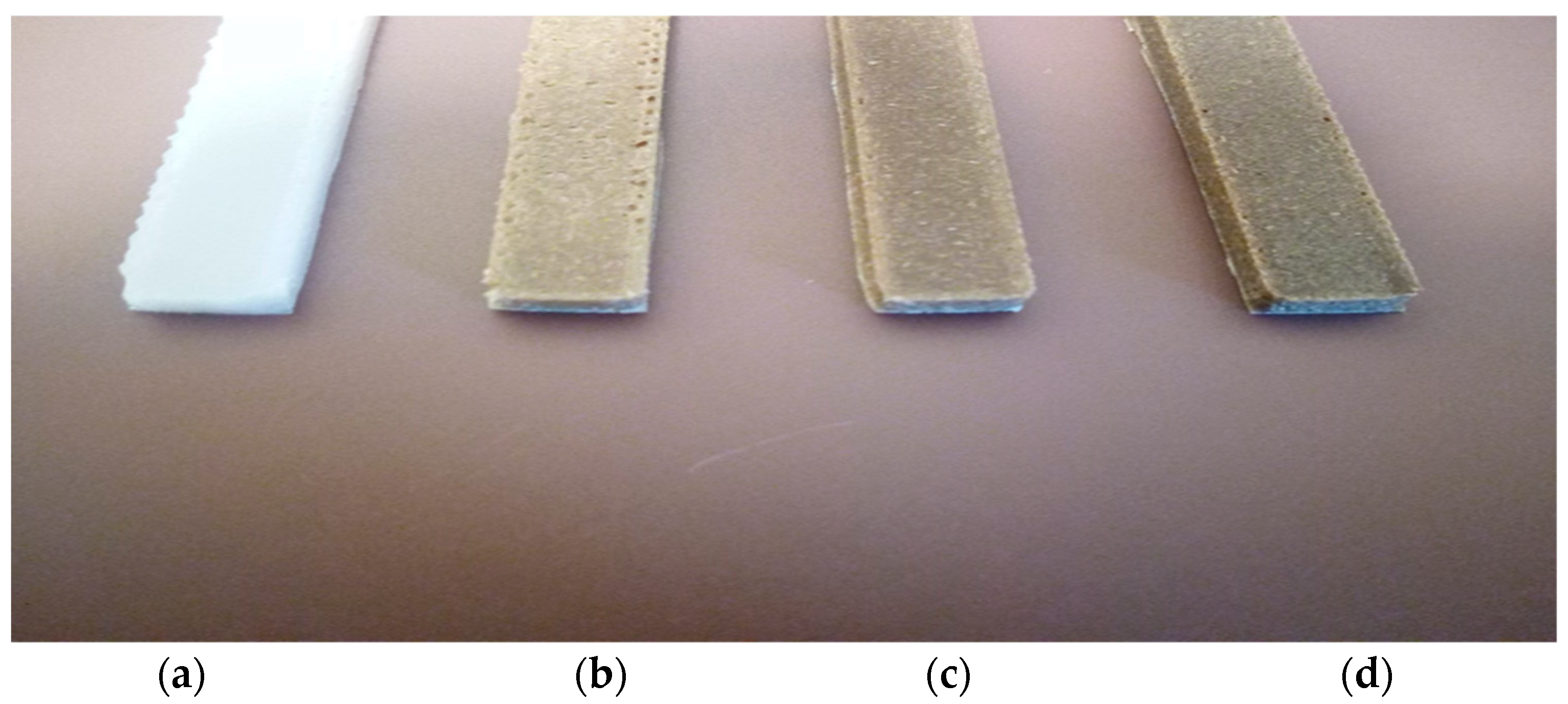
| T1 | T2 | T3 | T4 | T5 | T6 | T7 | T8 |
|---|---|---|---|---|---|---|---|
| 140 °C | 140 °C | 140 °C | 150 °C | 150 °C | 140 °C | 140 °C | 140 °C |
| The speed of rotation of the screw | 200 rpm | ||||||
| Filament collection speed | 4.6 m/min | ||||||
| Temperature | 195 °C |
| Printing speed | 30 mm/min |
| Printing speed | 35 °C |
| Cooling fan | 100% |
| Weft angle | 45° |
| Samples | 0%TT | 5%TT | 10%TT | 15%TT |
|---|---|---|---|---|
| porosity | 26.5% | 22% | 18% | 16% |
| Samples | Tc (°C) | Tm (°C) | ∆Hm(J/g) | ∆Hc(J/g) |
|---|---|---|---|---|
| PBSA Pur | 86.91 °C | 17.04 °C | 18.38 | 32.59 |
| PBSA 5 TT | 90.51 °C | 51.43 °C | 29.17 | 21.98 |
| PBSA 10 TT | 87.18 °C | 47.52 °C | 28.85 | 24.87 |
| PBSA 15 TT | 88.72 °C | 48.83 °C | 30.32 | 24.30 |
Publisher’s Note: MDPI stays neutral with regard to jurisdictional claims in published maps and institutional affiliations. |
© 2022 by the authors. Licensee MDPI, Basel, Switzerland. This article is an open access article distributed under the terms and conditions of the Creative Commons Attribution (CC BY) license (https://creativecommons.org/licenses/by/4.0/).
Share and Cite
Niang, B.; Schiavone, N.; Askanian, H.; Verney, V.; Ndiaye, D.; Diop, A.B. Development and Characterization of PBSA-Based Green Composites in 3D-Printing by Fused Deposition Modelling. Materials 2022, 15, 7570. https://doi.org/10.3390/ma15217570
Niang B, Schiavone N, Askanian H, Verney V, Ndiaye D, Diop AB. Development and Characterization of PBSA-Based Green Composites in 3D-Printing by Fused Deposition Modelling. Materials. 2022; 15(21):7570. https://doi.org/10.3390/ma15217570
Chicago/Turabian StyleNiang, Babacar, Nicola Schiavone, Haroutioun Askanian, Vincent Verney, Diène Ndiaye, and Abdoulaye Bouya Diop. 2022. "Development and Characterization of PBSA-Based Green Composites in 3D-Printing by Fused Deposition Modelling" Materials 15, no. 21: 7570. https://doi.org/10.3390/ma15217570







